Owner Set Up: Difference between revisions
From WMS
Lwinchester (talk | contribs) |
Lwinchester (talk | contribs) |
||
| Line 242: | Line 242: | ||
|Allow Duplicate Owner Pallet Id ** || If customer pallet id’s are required, are duplicates allowed? || Y or N || Defined by the client | |Allow Duplicate Owner Pallet Id ** || If customer pallet id’s are required, are duplicates allowed? || Y or N || Defined by the client | ||
|- | |- | ||
|Owner Batch Id ** || Specifies whether a customer rotation is required || N Don't use cust batch numbers <br> R | |Owner Batch Id ** || Specifies whether a customer rotation is required || N Don't use cust batch numbers <br> R - As Y - returns are restricted <br> Y - Use customer batch numbers || Defined by the client | ||
|- | |- | ||
|Auto Quarantine All Stock ** || Rather than on product level, allows you to auto hold all products for this owner at receipt || Y or N Defined by the client | |Auto Quarantine All Stock ** || Rather than on product level, allows you to auto hold all products for this owner at receipt || Y or N || Defined by the client | ||
|- | |- | ||
| Reason || Reason code for the auto quarantine if auto quarantine is set to ‘Y’ || Must exist on reason codes maintenance or left blank if no auto quarantine – LOV available || Defined by the client | | Reason || Reason code for the auto quarantine if auto quarantine is set to ‘Y’ || Must exist on reason codes maintenance or left blank if no auto quarantine – LOV available || Defined by the client | ||
Revision as of 11:26, 22 April 2010
INTRODUCTION
This document describes the required screens to be used in setting up the information concerned with the Owners of stock in the warehouse. Other guides describe the set up of company, user, warehouse, stock etc.
This is a generic guide based on the version of the SCE system at the time of writing.
It can also be used by clients to specify their specific data values to aid initial system set up as well as for future reference.
Note that fields marked ‘**’ are mandatory and are needed to ensure correct set up of the system.
Owner Maintenance – Main Tab
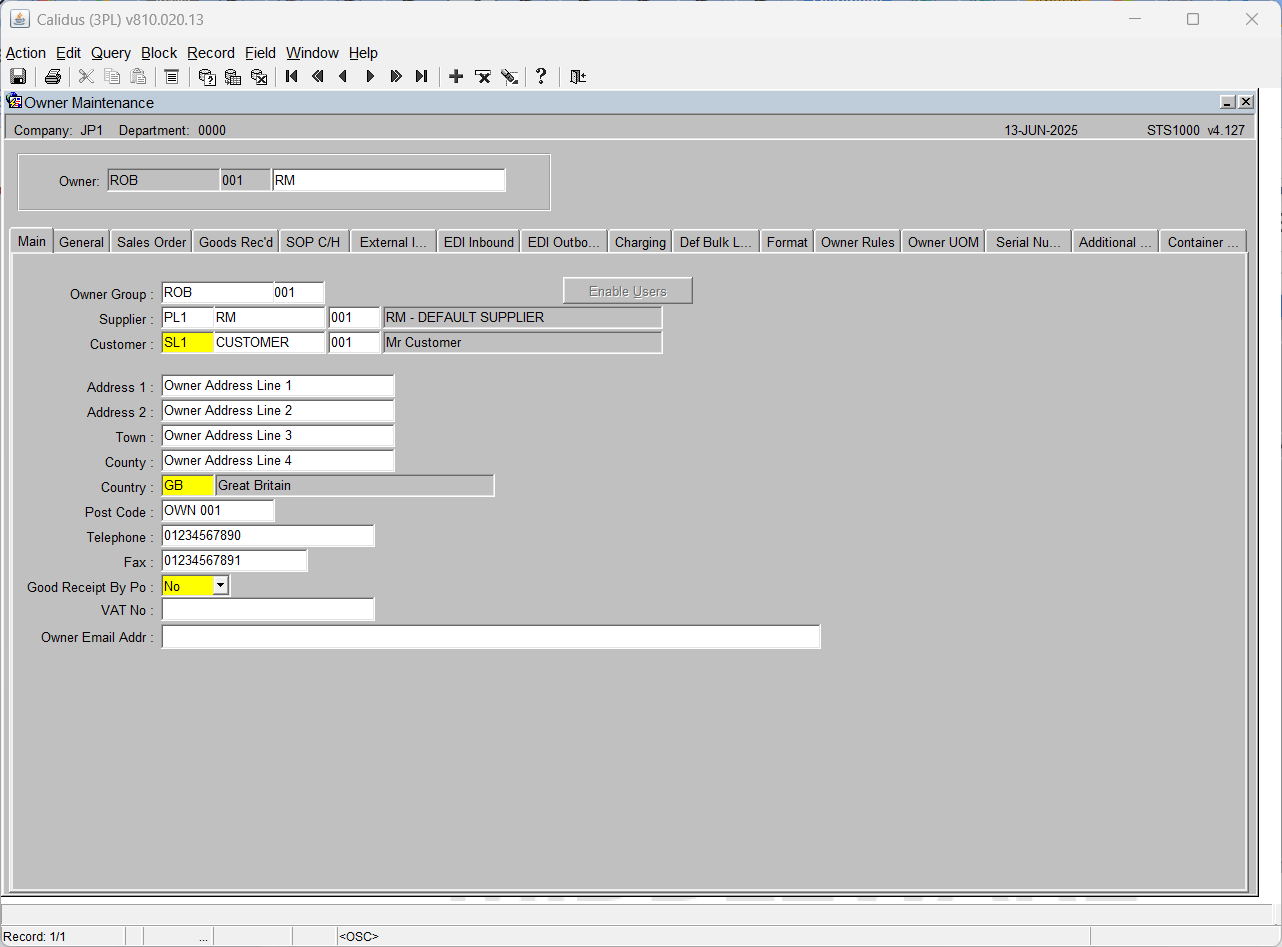
| Field Name | Description | Options | Generic Value |
| Owner ** | Owner code – note, in order to setup an owner from scratch – you must have registry setting ‘OwnerSuperUser’ set to ‘1’ | 10 character free text field – note, for RF and other processing, the owner code must only be 3 characters – LOV available in query mode | Defined by the client |
| SubCode ** (not labelled) | Sub code of the owner – this allows the user to have the same owner code with multiple entries, however, the standard is always ‘001’ | 3 character free text field | 001 |
| Description (not labelled) ** | The name of the owner | 30 character free text field | Defined by the client |
| Owner Group ** | Used for edi reporting purposes, the ability to group multiple owners under one owner. This then becomes the master and the ‘owner group’ – (not migrated) | Must exist in owner maintenance – will default to current owner code – LOV available | Defined by the client |
| Supplier – 1st field – ledger code ** | Ledger code associated with the supplier | Must have been created in ledger codes maintenance and assigned to the user id – always PL1 | PL1 |
| Supplier – 2nd field – supplier code | Default supplier for the owner – this can be used at goods receipt to automatically default in this supplier code at pre advice | Must have been created in partners maintenance – LOV available | Defined by the client |
| Supplier – 3rd filed – supplier sub code | The sub code for the default supplier for the owner | 001 or left blank | Defined by the client |
| Customer – 1st field – ledger code ** | Ledger code associated with the customer | Must have been created in ledger codes maintenance and assigned to the user id – always SL1 | SL1 |
| Customer – 2nd field – customer code | Default customer for the owner | Must have been created in partners maintenance or customer wizard – LOV available | Defined by the client |
| Customer – 3rd filed – customer sub code | The sub code for the default customer for the owner | 001 or left blank | Defined by the client |
| Address 1 | The first line of the address for the owner | 30 character free text field or left blank | Defined by the client |
| Address 2 | The second line of the address for the owner | 30 character free text field or left blank | Defined by the client |
| Town | The town in which the owners address is situated | 30 character free text field or left blank | Defined by the client |
| County | The county in which the owners address is situated | 30 character free text field or left blank | Defined by the client |
| Country ** | The country in which the owners address is situated | Must have been created in country codes maintenance – LOV available | Defined by the client |
| Post Code | The post code for the owners | 10 character free text field or left blank | Defined by the client |
| Tel | The tel no for the owners address | 20 character free text field or left blank | Defined by the client |
| Fax | The fax no for the owners address | 14 character free text field or left blank | Defined by the client |
| Gr By Po ** | Defines whether receipts by purchase orders are required (not migrated) | Y or N | N
|
Owner Maintenance – General Tab
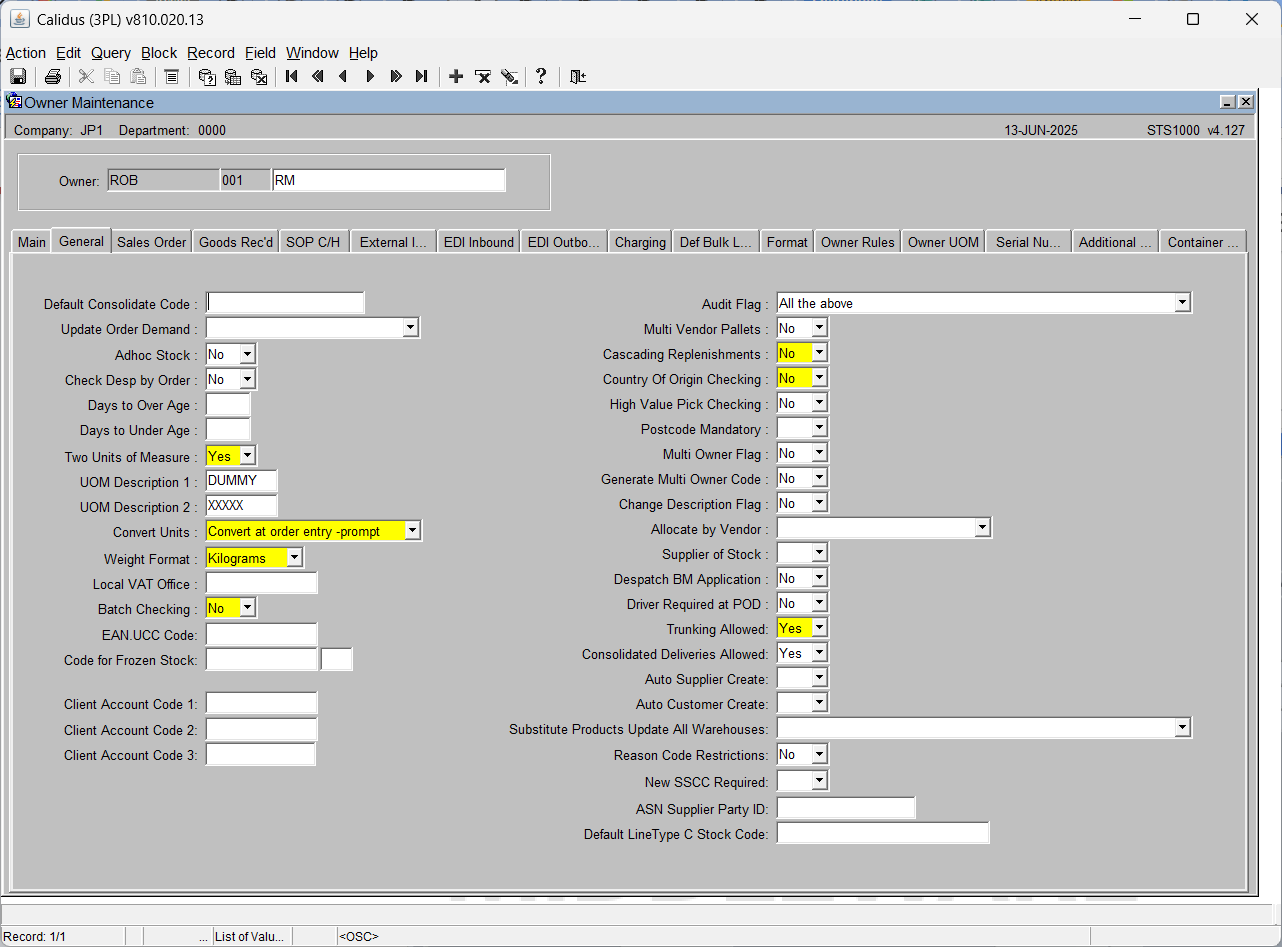
| Field Name | Description | Options | Generic Value |
| Default Consolidate Code | Allows you to enter a code which will validate against the owner’s receipts and orders to be consolidated from collection no. or advice note and order header details – client specific (not migrated) | None | Blank |
| Update Order Demand | Allows you to update the order demand records (used for reporting purposes) – not migrated | 1 – Update with ordered quantity 2 – Update with pick confirmed quantity or left blank |
Blank |
| Adhoc Stock | If set to ‘Y’, allows the user to be automatically taken into the stock set up screen if they enter a product that does not exist (not migrated) | Y or N or left blank | Defined by the client |
| Check Desp by Order | Enables the prevention of despatching orders on a route load individually | Y, N or left blank | Defined by the client |
| Adhoc Customer | If set to ‘Y’, allows the user to be automatically taken into the partners set up screen if they enter a customer that does not exist (not migrated) | Y, N or left blank | Defined by the client |
| Adhoc Supplier | If set to ‘Y’, allows the user to be automatically taken into the partners set up screen if they enter a supplier that does not exist (not migrated) | Y, N or left blank | Defined by the client |
| Days to Over Age | As per the same stock fields, this states how many days the product is in the warehouse before it is over age (see stock maintenance guide for details) – this value will apply to all products for this owner (not migrated) | 0 – 999 or left blank | Blank |
| Days to Under Age | As per the same stock fields, this states how many days the product is in the warehouse before it is under age (see stock maintenance guide for details) – this value will apply to all products for this owner (not migrated) | 0 – 999 or left blank | Blank |
| Two Units of Measure ** | Dictates whether the owner will be using cases and units, rather than just cases | Y or N | Defined by the client |
| UOM Description 1 | Description of the highest unit of measure to be used if two units of measure flag is set to Y (not migrated) | Must have been set up in unit of measure maintenance or left blank – LOV available | Blank |
| UOM Description 2 | Description of the lowest unit of measure to be used if two units of measure flag is set to Y (not migrated) | Must have been set up in unit of measure maintenance or left blank – LOV available | Blank |
| Convert Units ** | Specifies whether, if using two units of measure, you wish the system to explode the number of units into cases | N – Do not convert units to cases Y – Convert at order entry – Prompt E – Convert at order entry – do not prompt |
Defined by the client |
| Weight Format ** | The default weight for the owner | Must exist on the ml_captions table for weight_format | Defined by the client |
| Local Vat Office | Specifies the reference number for the location VAT office | 10 character free text field or left blank | Blank |
| Batch Checking ** | Do you require the system to do an additional check on batch quantities. I.e. for stock adjustments, the user will be prompted for a batch amount – the adjustment will not be completed until the amount adjusted = the batch amount (not migrated) | Y or N | N |
| Audit Flag ** | Determines what auditing records the system will keep. This will note changes to the various records for future reference (partially migrated) | 0 None 1 Stock and Owner 2 Bonded Stock and Bonded Owner 3 Stock Records Only 4 Owner Records Only 5 Bonded Owner and Owner 6 Bonded Stock and Stock 7 All the above – will default to ‘Stock and Owner’ |
1 |
| Multi Vendor Pallets | Specifies whether the owner will have more than one supplier – this will flag for a supplier code to be entered at all positive additions to stock quantities (not migrated) | Y or N | N |
| Cascading Replenishments ** | Does the owner use cascading replenishment. This is used if the owner has multiple uoms and wishes to cascade the replenishment to each one i.e. unit to box, box to case, case to pallet and back down again (not migrated) | Y or N | N |
| Country of Origin Checking ** | Determines whether the system will force the user to validate the country of origin during processing (not migrated) | Y or N | N |
| High Value Pick Checking ** | Are high value check digits required prior to pick confirmation? (not migrated) | Y, N or left blank | Blank |
| Postcode Mandatory | Is the postcode to be mandatory for customers address? (not migrated) | Y, N or left blank | Blank |
| Multi Owner Flag | Is this owner a multi owner or not. If set to Y, can be used to enable multi owner ordering under one owner i.e. if one product exists under 2 owners, an order placed under this owner would allow allocation from either (not migrated) | Y, N or left blank | Blank |
| Generate Multi Owner Code | If the owner is a multi owner, should the system generate a multi owner reference? (not migrated) | Y, N or left blank | Blank |
| Change Description Flag | Determines whether, if copying a product to a new product, whether the product description can be changed | Y, N or left blank | Blank |
| Allocate by Vendor | If allocate by vendor = 1 or 2, the system will prompt you for a supplier on order entry. If there is insufficient stock for this stock/supplier combination, (even if there is stock for a different supplier) the allocation will fail (not migrated) | 0 - Do not allocate by supplier 1 - Allocate-update for types 1-8 2 - Allocate-update for all types or left blank |
Blank |
| Supplier of Stock | If this flag is set to ‘Y’, the system will prompt for a supplier at goods receipt (not migrated) | Y, N or left blank | Blank |
| Despatch BM Application | Determines whether a BM application number is required at despatch – client specific (not migrated) | Y, N or left blank | Blank |
| Driver Required at POD | Specifies whether, at POD confirmation a drivers name is required (not migrated) | Y or N – will default to No | No |
| Code for Frozen Stock | A field for a ‘virtual owner’ code to be used to allow changes of state of stock by ‘change of ownership’ (i.e. frozen to chilled etc) without using a product level flag | 10 character free text field plus sub code field or left blank | Blank |
| EAN.UCC Code | Used for SSCC number/label production – this client specific company prefix number is used within the SSCC autogenerated number | 10 character free text field or left blank | Blank |
| Client Account Code 1 | Client specific additional reference code for the owner | 10 character free text field or left blank | Blank |
| Client Account Code 2 | Client specific additional reference code for the owner | 10 character free text field or left blank | Blank |
| Trunking Allowed ** | Used in conjunction with the waybill screen, specifies whether orders can be Mantled (Mantling relates to a delivery to an intermediate distribution centre before the individual shipments are separated according to their end delivery points) – the waybill screen will check this flag to see if this process is required | Y or N | Defined by the client |
| Consolidated Deliveries Allowed ** | Used in conjunction with the waybill screen, specifies whether orders can be Samtaxered (Samtaxering relates to the grouping of multiple orders for the same delivery point and the subsequent production of one Waybill) – the waybill screen will check this flag to see if this process is required | Y or N | Defined by the client
|
Owner Maintenance - Sales Order Tab
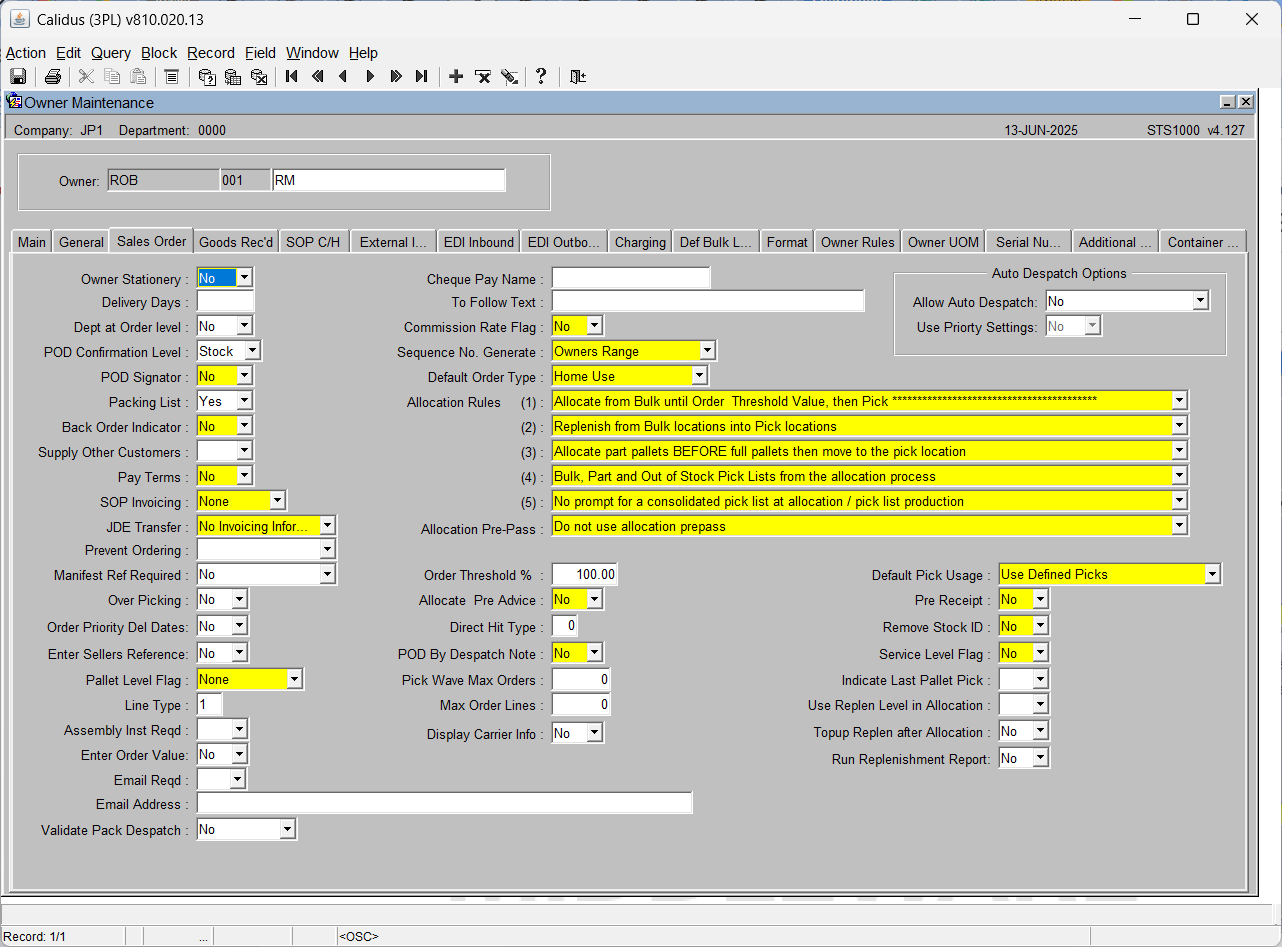
| Field Name | Description | Options | Generic Value |
| Owner Stationery | Is documentation produced from the WMS to be pre-printed on the client’s own stationery? (not migrated) | Y or N – will default to No | N |
| Delivery Days | Indicates how many days are required to deliver stock for this owner (not migrated) | 0 – 999 or left blank | Blank |
| Dept. At Order Level | Determines whether a department code should be prompted for at order entry (not migrated) | Y, N or left blank | Blank |
| POD Confirmation Level | Determines whether POD will be actioned at stock or pallet level (not migrated) | S - POD Confirm at Product level (no regard for batch or pallets) P - POD Confirm at Batch/Pallet level – or left blank |
Blank |
| POD Signator ** | Determines whether a signature is required at entry of POD before confirmation is allowed | Y or N | Defined by the client |
| Packing List | Determines whether a packing list is required, and if so, at what point. Note, this is based on the ‘old’ packing functionality. If set to ‘Y’ and then use the new packing screens, the system will prevent you from despatching orders. | N No P Pick Y Yes |
N |
| Back Order Indicator ** | Used in conjunction with product and product class flags to determine whether back ordering is required (not migrated) | Y or N | N |
| Supply Other Customers | Indicates whether this owner will supply other owners’ customers (not migrated) | Y, N or left blank | Blank |
| Pay Terms ** | Used in the old invoicing functionality – if flag set to ‘Y’, would override standard payment terms (not migrated) | Y, N or left blank | Blank |
| SOP Invoicing ** | Relates to old invoicing functionality – determines when invoicing is to be produced (not migrated) | N – None I – Immediate W – Weekly |
None |
| JDE Transfer ** | Relates to old invoicing functionality – whether the invoices are to be interfaced to JDE (not migrated) | C Client Invoicing N No Invoicing Information S SOP Invoicing Y Submit all invoices to JDE |
N |
| Prevent Ordering | Used in conjunction with a similar flag at customer level, will determine whether sales orders can be generated or not | Y – Prevent ordering for all customers C – Prevent ordering if the customer flag is set to ‘Y’ N – Do not prevent ordering – or left blank |
Blank |
| Manifest Ref Required | Used in population of the PCK tables for packing messages. If set to ‘Y’ will prompt for a manifest reference at order entry. This will then be written to the PCK tables (Kewill) | Y, N or left blank | Blank |
| Over Picking | States whether the owner allows over picking at pick confirmation | Y, N or left blank | Blank |
| Cheque Pay Name | Used in old invoicing functionality – the name to appear on the cheque (not migrated) | 20 character free text field or left blank | Blank |
| To Follow Text | Used in old invoicing functionality – ‘to follow’ text to appear on invoicing documentation – (not migrated) | 40 character free text field or left blank | Blank |
| Commission Rate Flag ** | Used in old invoicing functionality – determines whether the commission rate should be overridden (not migrated) | Y or N | N |
| Sequence No. Generate ** | Determines how the order number is generated when entering an order at order entry and/or edi (all migrated apart from no.4) | 1 General Range 2 Owners Range 3 Mandatory 4 Prefix with Order Class |
1 |
| Pallet Level Flag ** | Determines whether pallet levelling is required, and if so, how (not migrated) | C By No. of Cases N None P Pallet Fill Factor |
N |
| Default Order Type ** | Specifies the default order type for this owner | C Community (EU) E Export H Home Use O No default processing |
H |
| Line Type ** | Specifies the default line type. This will dictate how the system allocates stock and in what priority | 1 – Standard 2 - Non-Stock 3 - Rotation 4 - Pallet 5 - Cust Rotation 6 - Cust Pallet R - Rot - Nocommit |
1 |
| Allocation Rules (1) ** | Dictates in what sequence the system will allocate the stock | 0 Bulk Until OT Then Pick 1 Pick Locations first 2 Bulk Locations first 3 ONLY from Pick Locations 4 ONLY from Bulk Locations 5 Partial Multi-Deep First 6 Sequence Against Stock 7 As 6 Till OT then Rule 3 Reverse |
Defined by Client |
| Allocation Rules (2) ** | Dictates the sequence for replenishment | 0 Replenish Bulk -> Pick 1 Replenish Replen -> Pick 2 Replenish Bulk -> Rep -> Pick 3 Do NOT Replen in Allocation |
3 |
| Allocation Rules (3) ** | Dictates the sequence for allocating part pallets vs full (bulk) pallets | 0 Part In Sequence 1 Part Before Full Pallets 2 Part After Full Pallets 3 Part in Sequence- Move to Pick 4 Part Before Full - Move to Pick 5 Part After Full - Move to Pick 6 Part Before Full - Rp Pt In Seq 7 Part After Full - Rp Pt in Seq 8 Pt Bf Ful - Rp Pt in Sq Mv Pick 9 Pt Af Ful - Rp Pt in Sq Mv Pick |
0 |
| Allocation Rules (4) ** | Dictates when and how the pick lists are produced (currently only 0 is applicable) | 0 Blk Prt and OOS PL from PL 1 Blk and Prt PL (Sep) from PL 2 Prt and OOS PL from PL 3 Blk and Prt (Cmb) from PL 4 Blk and Prt (Cmb). OOS from PL 5 Blk Prt and OOS from Alloc 6 Blk and Prt (Sep) from Alloc 7 Prt and OOS from Alloc 8 Blk and Prt (Cmb) from Alloc 9 Blk and Prt (Cmb). OOS Alloc |
0 |
| Allocation Rules (5) ** | Dictates whether consolidated pick list is required and whether the system is required to prompt for it (not migrated) | 0 No prompt for Con PL at ALL/PCK 1 Do Prompt for Con PL at ALL/PCK |
0 |
| Allocation Pre-Pass ** | Determines whether the system should reset the order back to committed if there is insufficient stock in the warehouse, dependant on what level you wish it to restrict. | 0 Accept Shortages 1 Do Not Short Alloc. Order line 2 Do Not Short Alloc. Product Type 3 Do Not Short Alloc. Order 4 Do Not Short Alloc. Range C As N -unalloc set to committed N Do Not Use Allocation Prepass Y Use Allocation Prepass |
N |
| Order Threshold | Works in conjunction with allocation rule 1. The Break Point as a % of a Standard Pallet when Allocation will switch from Bulk to Pick | 0 – 100 or left blank | Defined by the client |
| Default Pick Usage ** | Will determine whether allocation has to allocate from pick locations first. Note, if this is set to 0 or 1, allocation will fail if no pick locations are set against the products | 0 Use Defined Picks <br 1 Must Exist Before Allocation 2 Do Not Use Defined Picks |
2 |
| Alloc Pre-Advice ** | Specifies whether stock is allowed to be allocated if it is at the pre advice stage (not migrated) | Y or N | N |
| Pre Receipt ** | Specifies whether stock is allowed to be allocated if it is at receipt confirmed stage (not migrated) | Y or N | N |
| Direct Hit Type ** | Direct Hit type works in conjunction with the allocation rules. It uses the actual ordered quantity to specify which pallet to allocate from. The system will look for a pallet with the exact or nearest quantity available to that ordered. Dependant on which hit type used, determines which sequence of locations it searches in to allocate. (not migrated) | 0 - Do not use Direct Hits 1 - Hit in Sequence specified against the stock code 2 - Hit in Sequence with preference to pick 3 - Hit in Sequence with preference to bulk 4 - Hit in stock code sequence then oldest part pallet greater than remainder. 5 - Hit in sequence with preference to pick then oldest part pallet greater than remainder. 6 - Hit in sequence with preference to bulk then oldest part pallet greater than remainder |
0 |
| Remove Stock Id ** | Determines whether all system ids i.e. pallet id, rotation, sell by dates etc are removed on transfer to a pick location (not migrated) | Y or N | N |
| POD by Despatch Note ** | Indicates whether POD is to be displayed in despatch note sequence (not migrated) | Y or N | N |
| Service Level Flag ** | Indicates whether a service level is mandatory at order entry (not migrated) | Y or N | N |
Owner Maintenance – Goods Received Tab
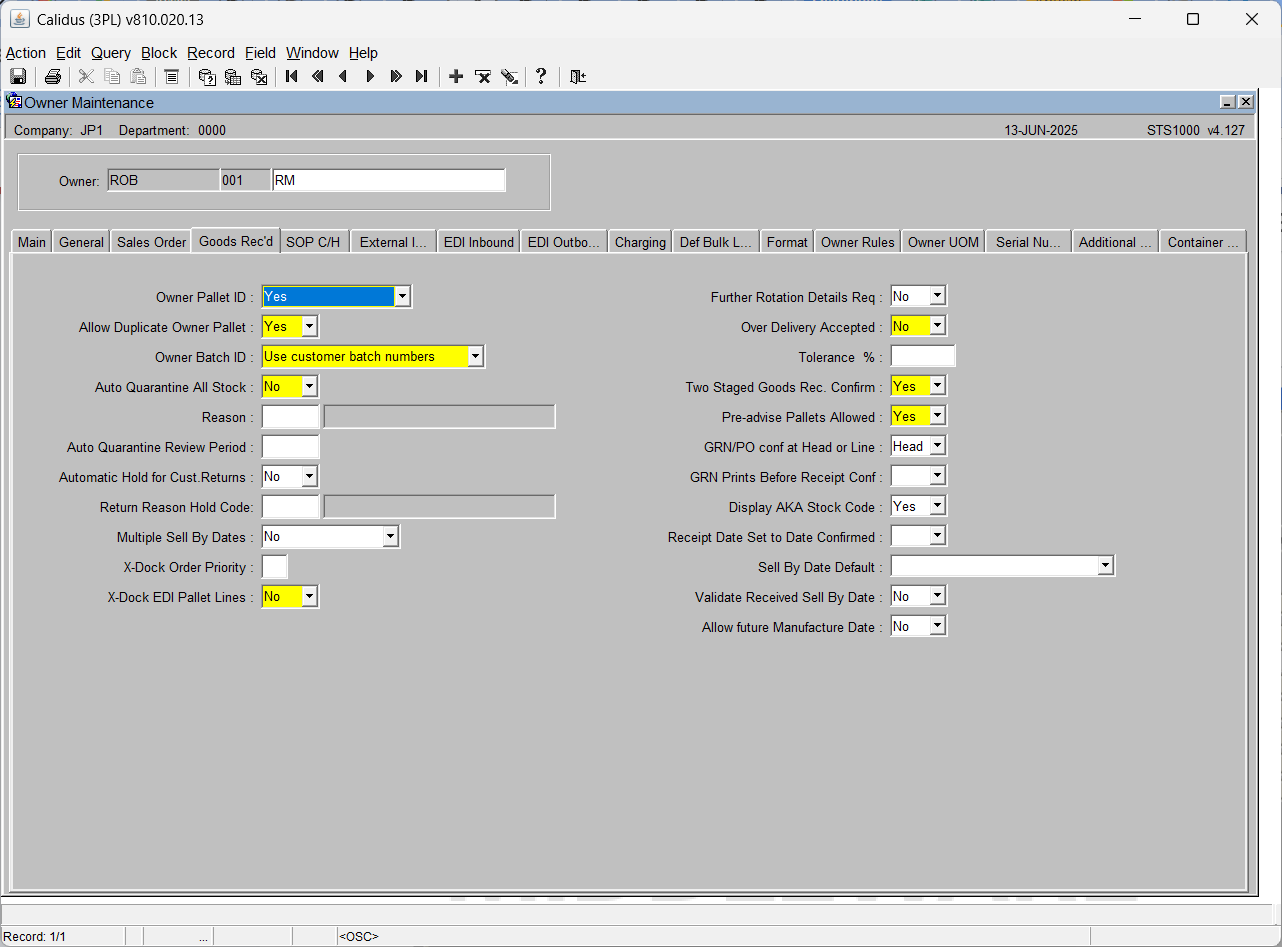
| Field Name | Description | Options | Generic Value |
| Owner Pallet Id ** | Specifies whether a customer pallet id is required | Y or N | Defined by the client |
| Allow Duplicate Owner Pallet Id ** | If customer pallet id’s are required, are duplicates allowed? | Y or N | Defined by the client |
| Owner Batch Id ** | Specifies whether a customer rotation is required | N Don't use cust batch numbers R - As Y - returns are restricted Y - Use customer batch numbers |
Defined by the client |
| Auto Quarantine All Stock ** | Rather than on product level, allows you to auto hold all products for this owner at receipt | Y or N | Defined by the client |
| Reason | Reason code for the auto quarantine if auto quarantine is set to ‘Y’ | Must exist on reason codes maintenance or left blank if no auto quarantine – LOV available | Defined by the client |
| Auto Quarantine Review Period | Sets the number of days the stock will be held under quarantine (not migrated) | 0 – 999 or left blank | Blank |
| Over Delivery Accepted ** | Used with purchase ordering, determines whether this owner is allowed to receive more stock than advised on the P.O. | Y or N | Defined by the client |
| Tolerance % | If over delivery is set to ‘Y’ – a percentage of how much over the advised quantity you are allowed to receive | 0 – 100 or left blank | Defined by the client |
| Two Staged Goods Rec. Confirm ** | Determines whether an additional stage of goods receipt is required (not migrated) | Y or N | N |
| Pre-Advise Pallets Allowed ** | Determines if, at goods receipt, you wish to enter pallet level information | Y or N | Defined by the client |
| Multiple Sell by Dates | Are pallets with the same rotation number allowed to have multiple sell by dates? (not migrated) | N No | N
S No but amendable Y Yes |
| X-Dock Order Priority | If an order priority code is entered here, only orders with that priority code can be cross docked | Must exist in order priority maintenance or left blank – LOV available | Defined by the client |
| X-Dock EDI Pallet Lines ** | Are the extra cross docked pallet details to be sent in the outbound receipt message (not migrated) | Y or N | N |
| Further Rotation Details Req | Are additional rotation details to be entered at receipt? | Y, N or left blank | Defined by the client |
| Automatic Hold for Cust. Returns | Are goods received as a customer return to be automatically put on hold? – will generate a system reason code of ‘89’ | Y or N | Defined by the client |
| GRN/PO Conf at Header or Line | Determines whether receipt confirmation will occur at header or line level (not migrated) | H - Head L - Line – will default to header |
H |
Owner Maintenance – SOP Charging Tab

| Field Name | Description | Options | Generic Value |
Owner Maintenance – EDI Tab
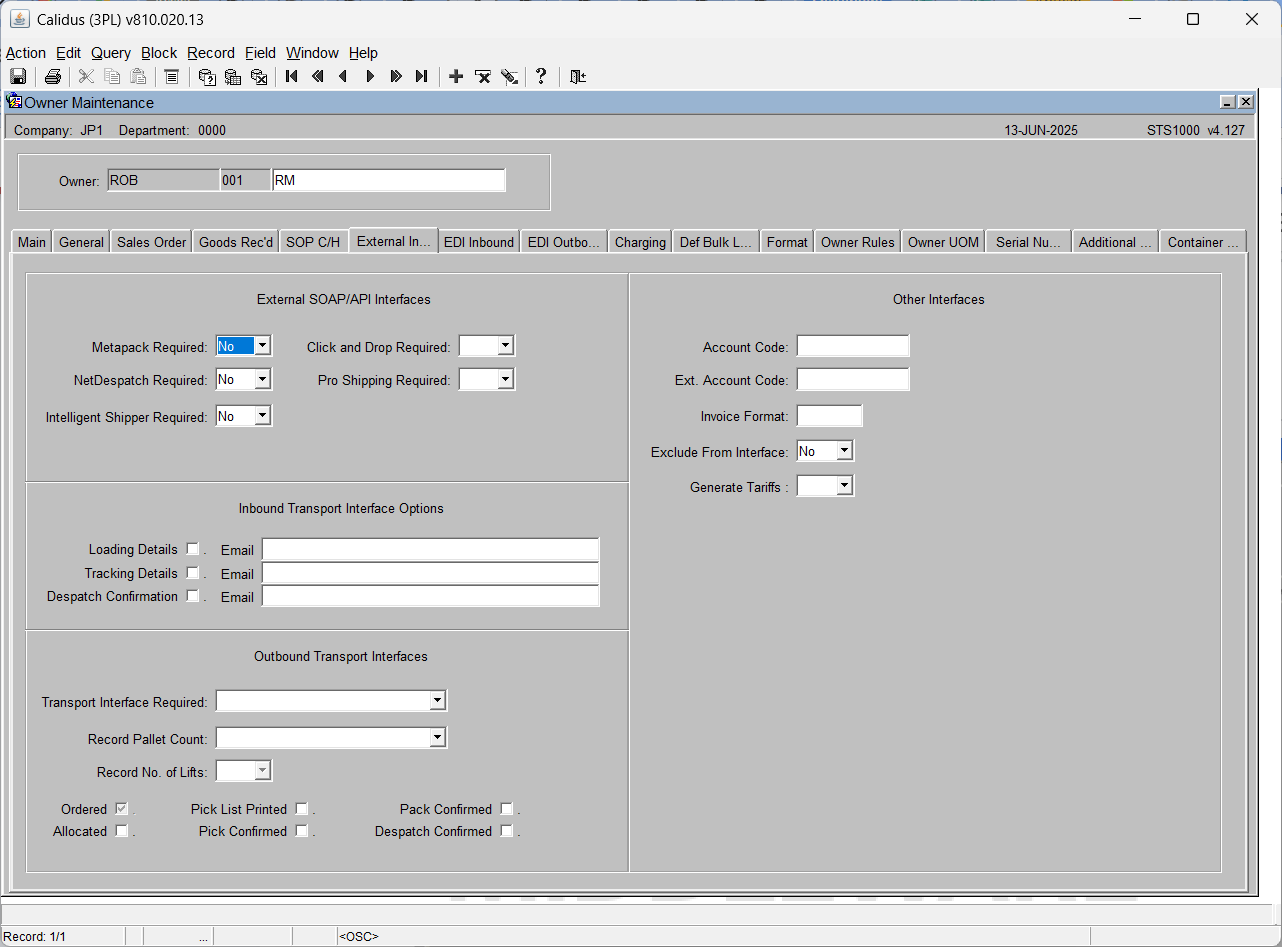
| Field Name | Description | Options | Generic Value |
Owner Maintenance – EDI Inbound Tab
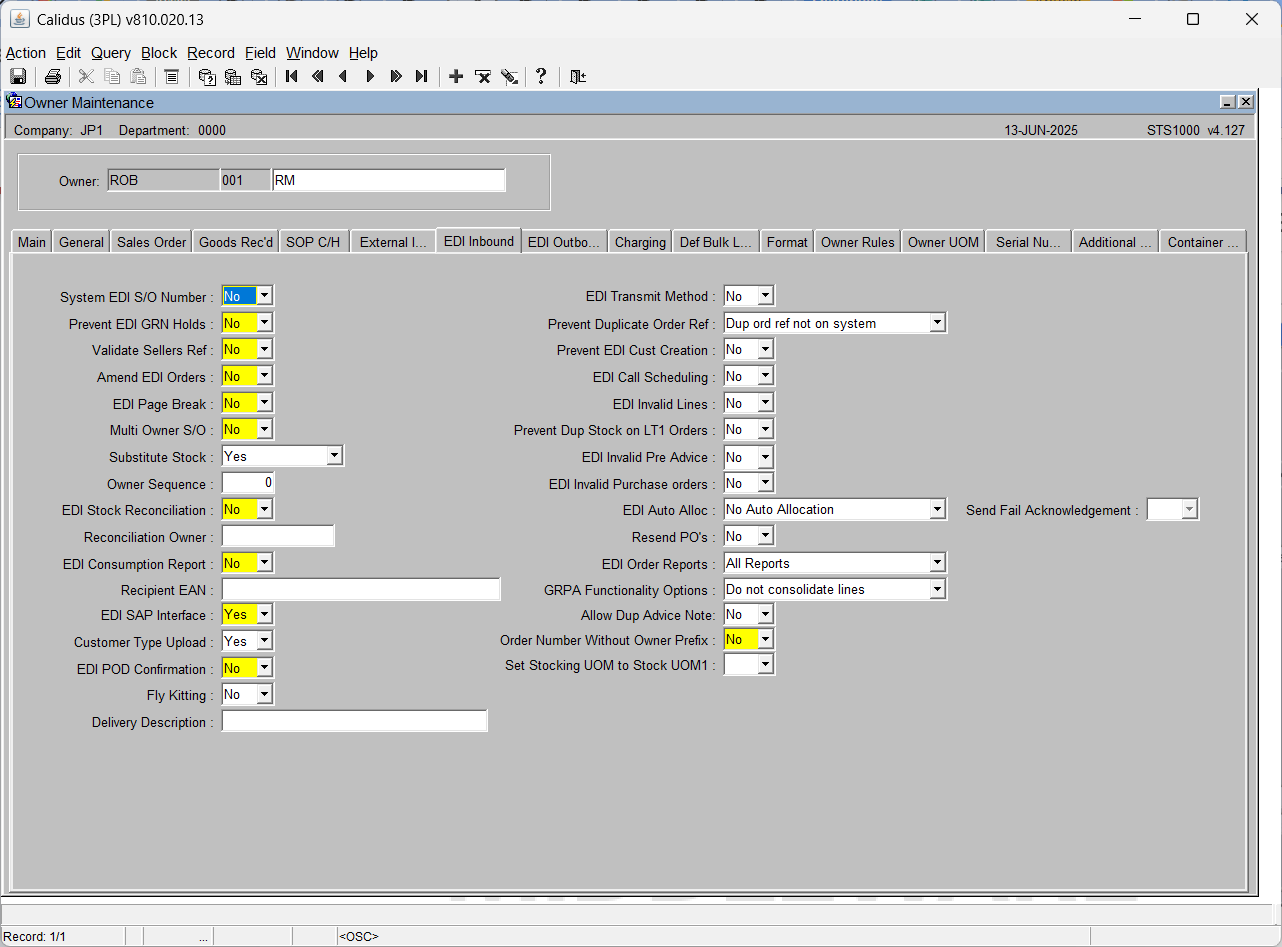
| Field Name | Description | Options | Generic Value |
Owner Maintenance – EDI Outbound Tab

| Field Name | Description | Options | Generic Value |
Owner Maintenance – Charging Tab
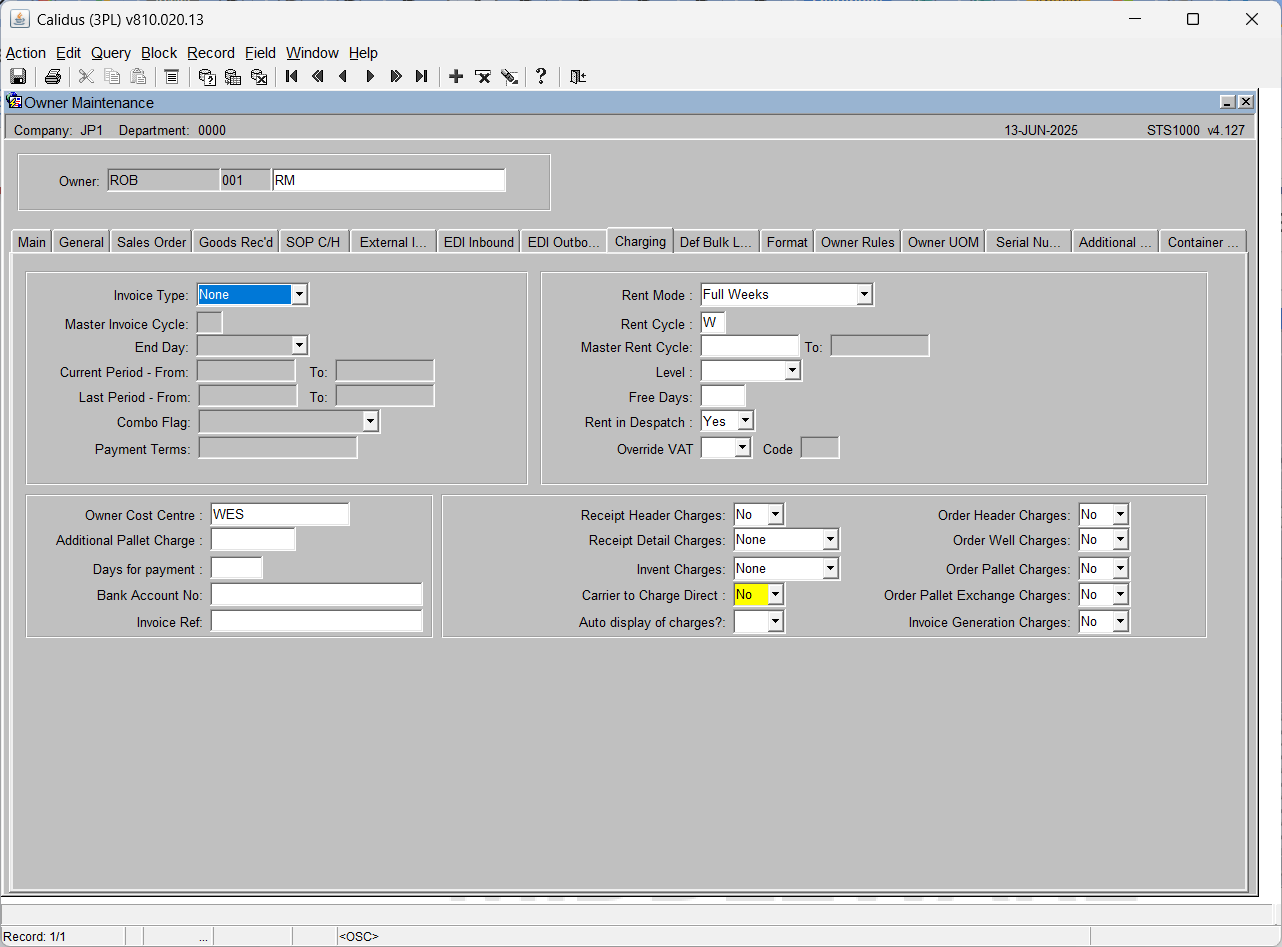
| Field Name | Description | Options | Generic Value |
Charging Tab – Cyclical Charges, Charges Tab
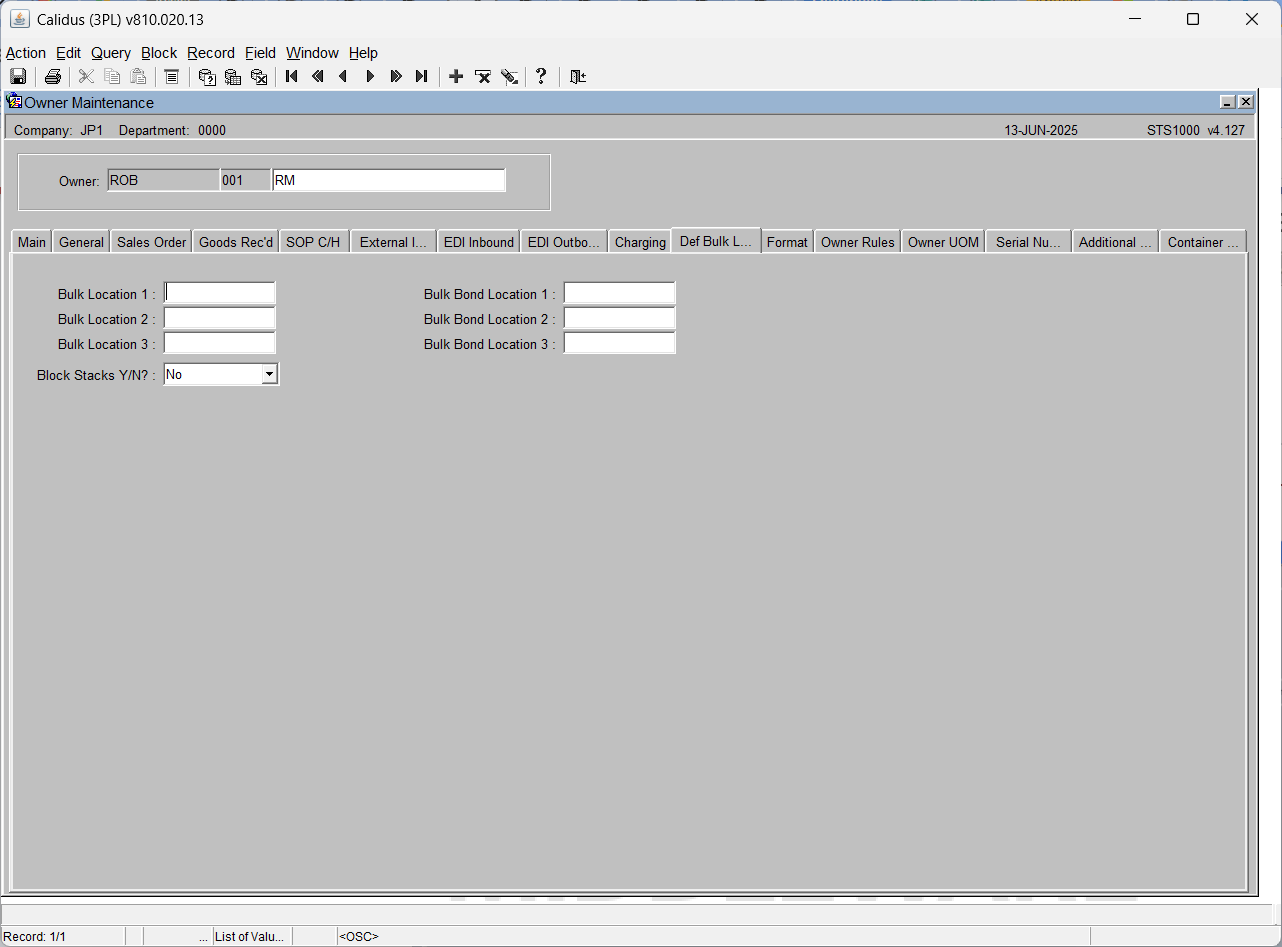
| Field Name | Description | Options | Generic Value |
Owner Maintenance – Default Bulk Locations Tab

| Field Name | Description | Options | Generic Value |
Owner Maintenance – Format Tab

| Field Name | Description | Options | Generic Value |
Owner Maintenance – Owner Rules Tab
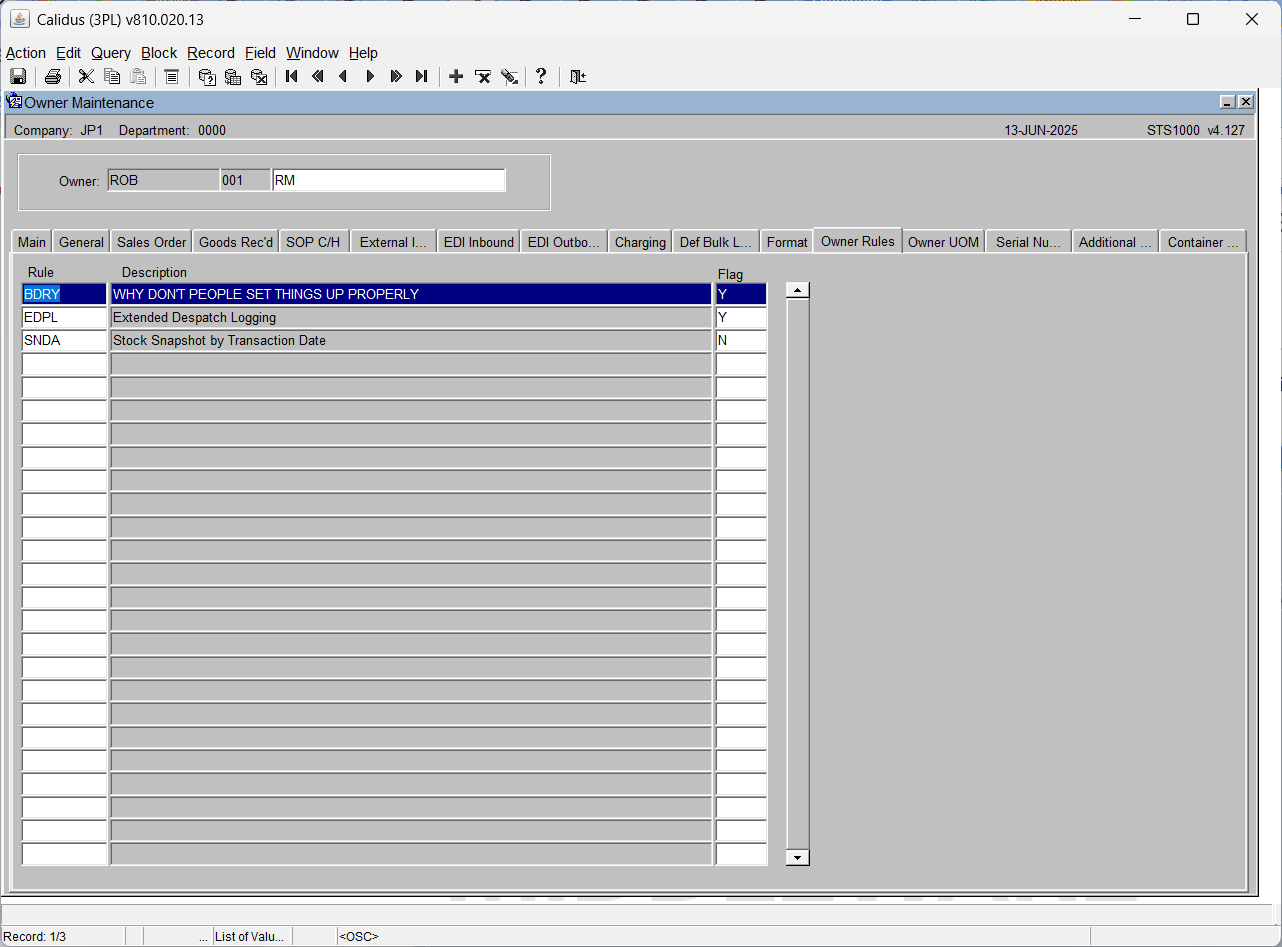
| Field Name | Description | Options | Generic Value |
Owner Maintenance – Owner UOM Tab
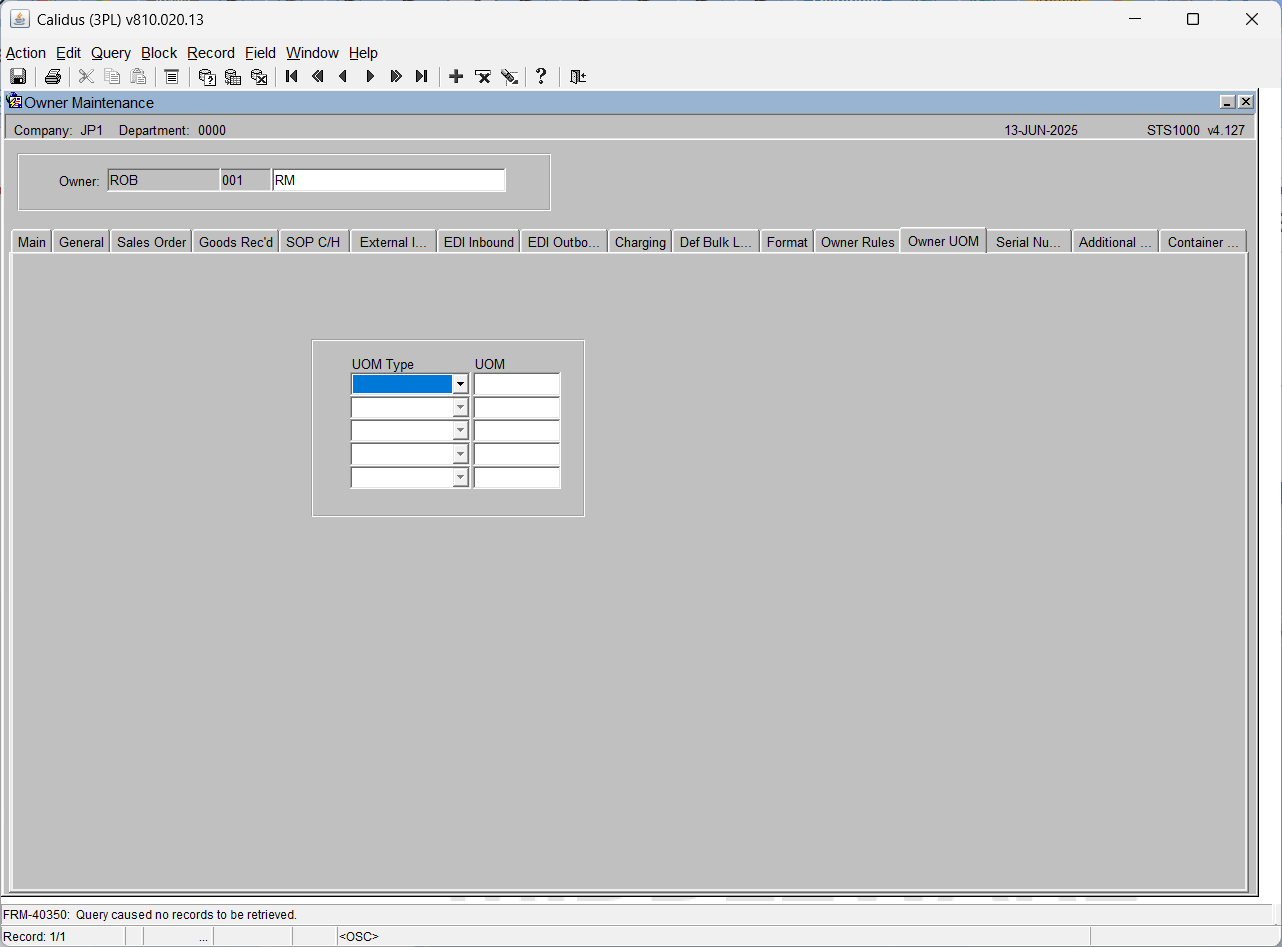
| Field Name | Description | Options | Generic Value |
Owner Maintenance – Unit of Sale Tab
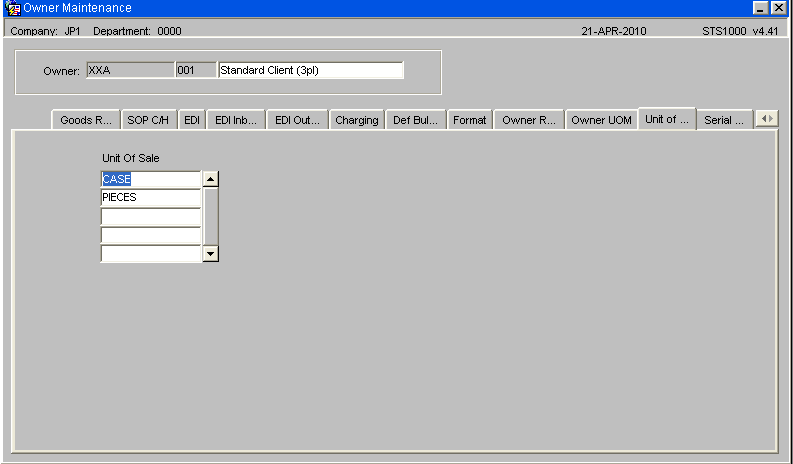
| Field Name | Description | Options | Generic Value |